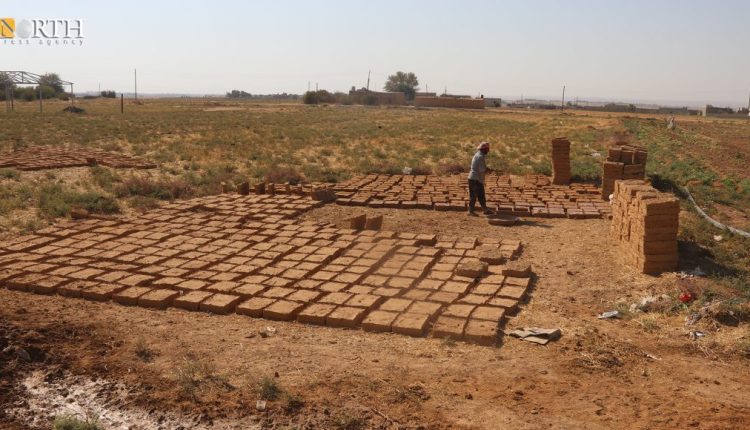
By Dilsoz Youssef
HASAKAH, Syria (North Press) – In the outskirts of Hasakah in northeastern Syria, people are turning to traditional mud house construction as a practical and cost-effective alternative to concrete homes amid severe economic challenges.
Khaled al-Aliyat, along with his son and brother, is hard at work crafting mud bricks by hand. They aim to complete their home before the onset of winter.
Recently, mud house construction has seen a resurgence, even as modern developments continue in the region. This shift is largely driven by the soaring costs of concrete and other building materials, a consequence of the country’s prolonged economic hardship after 13 years of war.
Limited resources
Al-Aliyat, a man in his forties, was displaced from the countryside of Sere Kaniye (Ras al-Ain) in the northwest of Hasakah after its occupation by Turkey and affiliated armed opposition factions, aka the Syrian National Army (SNA) in 2019.
Now, he resides in the village of Tel Sakhr in the northwest of Hasakah and relies on mud to build his home due to limited financial resources.
He explains that making his own mud bricks is a cost-effective solution until he can afford a concrete house.
One concrete block costs 5,000 Syrian pounds (SYP, equals about $0.35), which he cannot afford, says the daily laborer, speaking to North Press while covered in mud.
Mud homes offer practical advantages, being naturally cool in summer and warm in winter, thanks to the insulating properties of the material.
Concrete houses need air conditioning, while mud houses just need a regular fan to be comfortable, al-Aliyat notes.
The process of constructing a mud house involves several steps, starting with mixing hay and dirt, then kneading the mixture thoroughly before pouring it into pre-made molds. The bricks are left to dry in the sun for several days until they are ready for use.
Building with clay is a tradition deeply rooted in the region, passed down through generations. However, this practice had declined over the past decade due to urbanization. Now, it is experiencing a resurgence, driven by the worsening economic situation.
In rural areas, families and neighbors often come together to build clay houses, which not only reduces labor costs but also strengthens community bonds and fosters a sense of solidarity.
Available materials
In the village of Tel Fuweidat near the town of Tel Tamr, Yassin al-Jassem and his two brothers have completed about half of their new house. Yassin is busy arranging bricks near the house, waiting for them to dry so they can continue construction.
In his thirties, Yassin tells North Press that building with mud requires nothing more than human effort, water and dirt, which only need maintenance work each year.
He admits, however, the process can be slow as he only finished half of the house since the harvest season ended.
Similarly, Muhammad Malek, who has just finished his mud house, explains the main reason he chose to build with mud is the harsh financial situation.
While workers poured concrete floors to keep the rooms clean and prevent water seepage, he stresses that they focus on survival and mud houses are much cheaper than concrete ones.
With the Syrian pound’s value plummeting against foreign currencies, the cost of building a concrete house with two rooms and basic amenities is estimated to be no less than $20,000. In contrast, constructing a mud house costs no more than $500.
Malek adds that the price of a single concrete block from local factories ranges from 6,000 to 7,000 pounds ($0.38 – $0.45), while a bag of cement costs 93,000 SYP ($6).
Malek digs the ground to gather dirt and mix it with hay to build the house, which means it does not require additional expenses. Mud houses are ideal for both winter and summer, providing coolness and warmth.
